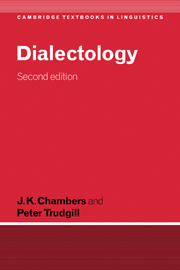2 - Dialect geography
Published online by Cambridge University Press: 05 June 2012
Summary
Casual observations about the way people speak are common topics of conversation. English people in America, for instance, soon come to expect that they will be told they have just said idear for ‘idea’, and Australians in England quickly grow immune to the remark that they pronounce the second syllable of ‘Australia’ as if it were rile. Among linguists, observations like these are so frequent that they sometimes impede normal conversation. But they are by no means restricted to linguists.
Indeed, it is very likely that dialect differences have been topics of conversation for as long as people have been talking to one another. One of the most venerable dialect observations, and perhaps the most fatal one, is recorded in the Old Testament, when the Gileadites were battling the Ephraimites along the Jordan. Whenever the Gileadites captured a fugitive, they asked him if he was an Ephraimite. If he said no, they would then ask him to name an ear of corn, which the Gileadites called a shibboleth. According to the scriptural account (Judges xii, 6), ‘He said sibboleth, for he could not frame to pronounce it right. Then they took him and slew him.’
The word shibboleth has entered English and many other languages with the meaning ‘test word’ or more generally ‘a distinguishing trait’.
- Type
- Chapter
- Information
- Dialectology , pp. 13 - 31Publisher: Cambridge University PressPrint publication year: 1998
- 1
- Cited by



